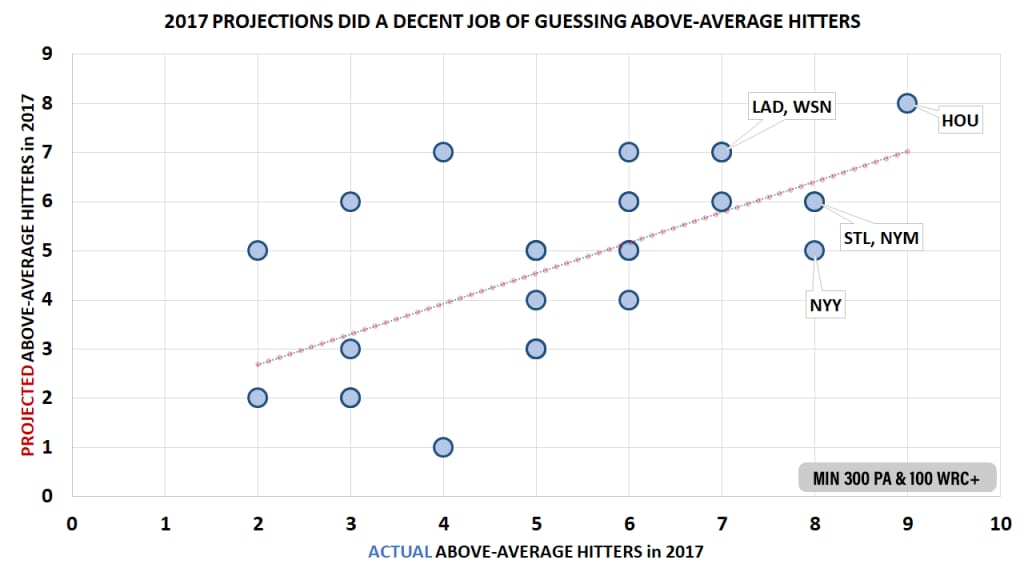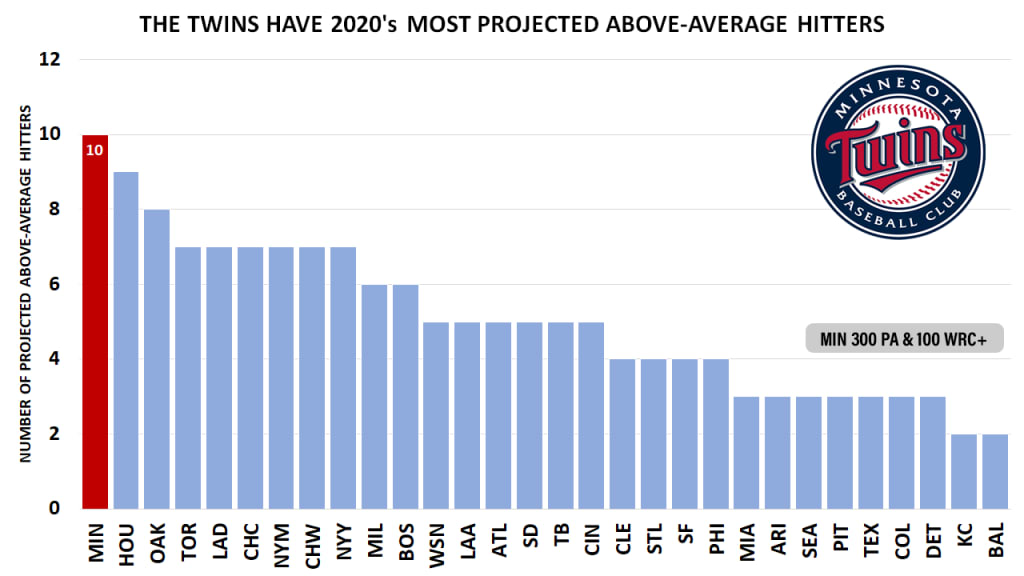As pitchers and catchers begin to report across Arizona and Florida, with just about every meaningful free-agent hitter save for Yasiel Puig signed, we can look ahead to the 2020 season and attempt to answer an interesting question: Which team has the deepest lineup?
That's a more difficult problem to solve than you might think. There's no straightforward definition for "deepest," other than an amorphous idea of "having lots of good hitters." Not only that, but if we're looking ahead, we can't just look at 2019 numbers. We have to look at 2020 projections. So to get to our list of "good hitters," we'll define it like this:
- We'll use the Steamer projections housed at FanGraphs
- We'll look only for players projected to have at least 300 plate appearances
- Of those, we'll look only for hitters projected to have an average-or-better 100 wRC+
Your mileage may vary! This is how we're doing it. This method gets us 155 hitters expected to receive regular playing time with average-or-better hitting, or about five per team, which sounds about right. It also works out very well with reality -- in 2019, there were 149 of those hitters, and in 2018 there were 159. So even though the 155 hitters we're projecting to be above-average won't be exactly the 155 or so who do it, the number of those hitters to expect is right about on track.
But before we look forward, let's briefly look back, because if none of this works, then what does any of it matter? Fortunately, we can, because remember, we did this back in the winter of 2016-'17 using the exact same method. At the time, we expected that the '17 Astros would have the deepest lineup for the upcoming season. (Houston, both here and elsewhere, was projected to be outstanding in '17, the season at the center of MLB's investigation into sign stealing.) Knowing all of our 30 team projections for '17, and how that season ended up playing out, how well did that attempt to look ahead actually work out?
Reasonably well, actually. The Astros did end up with the most average-or-above hitters, with nine. The Dodgers and Nationals had seven, just as expected, and at the other end, the Braves, Rockies, and Padres, each projected to have two, ended up with: three, three, and two. (For players who changed teams mid-season, we placed them with their original team.)

It's a little noisy, obviously, because a projection system is not a prediction system, but it's directionally correct and gives us a really good starting point.
But we don't care about 2017, right now. So all that said, here's what you came for: Which 2020 offense is projected to be the deepest? Congrats, Twins fans. You have the bombas.
2020's deepest projected team lineups
It is, indeed, the Twins, and for the most part, this shouldn't be surprising. They did just set the all-time record for home runs, after all, and they did just have nine such above-average hitters last year -- which would have been 11 if Byron Buxton (295 plate appearances) and Jason Castro (275) had made it to the 300 plate appearance minimum -- and, oh right, they also signed Josh Donaldson.

Let's take a closer look at the Twins, comparing what did happen in 2019 against what's projected to happen in 2020. Sorting by best '20 projections and going downward:
2020 Twins lineup -- 2019 actual // 2020 projected
(Using Weighted Runs Created Plus, where 100 is "average")
Josh Donaldson 132 // 137
Nelson Cruz 163 // 134
Miguel Sanó 137 // 121
Max Kepler 121 // 117
Eddie Rosario 103 // 110
Jorge Polanco 119 // 109
Luis Arráez 125 // 109
Byron Buxton 111 // 108
Mitch Garver 155 // 108
Marwin González 93 // 103
Of these 10 players, half of them -- Donaldson, Kepler, Rosario, Polanco, and Buxton -- are projected to perform in a roughly similar way to what they did in 2019.
Four of them are projected to still be good, but worse, all for good reasons. Cruz turns 40 in July and just put up his best-ever season, and projection systems take age into account. Arráez and Garver have no track record before 2019 to speak of, making the projections understandably conservative. They do take multiple years into account, so Sanó's injury-plagued '18 season (when he hit .199/.281/.398) gives the system some amount of pause. (He's also yet to stay healthy enough to reach 500 plate appearances in a season, despite reaching the Majors in '15.)
The final player, González, is projected to be better, because despite an only-OK 2019, the projections remember that he was excellent in '17 and good in '18. We'll take the under on the '20 projections here, however, taking into account both those '19 numbers and the fact that he played for the Astros three seasons ago, the year during which they were operating an illegal sign-stealing scheme, as outlined in this January's investigation and report from the Commissioner's Office.
But let's say this does happen, that all 10 of these guys stay healthy and productive, or if one doesn't, someone like Jake Cave or Alex Kirilloff or Willians Astudillo steps up to do it instead. If the Twins had 10 above-average hitters getting 300 plate appearances apiece, how would that stand up against the rest of baseball history?
Pretty well, as it turns out. We can't easily look up wRC+ in this way through history, so we'll turn to the very similar OPS+ instead, to look for teams with the most above-average hitters with at least 300 visits to the plate. Having eight such hitters isn't rare; that's happened nearly 80 times. Having nine hitters, as the Twins just did, is unusual but not unprecedented; it's happened 16 times.
But having 10 hitters, as the Twins might this season? It's happened just twice:
- The '83 Yankees, featuring Dave Winfield, Don Baylor and a rookie named Don Mattingly, among others
- The '09 Angels, starring Bobby Abreu, Vladimir Guerrero, Torii Hunter and Mike Napoli
Each club won at least 91 games. It's good to hit.
Back to 2020. Aside from the Twins, a few other clubs stand out here. How about the Blue Jays, tied for fourth with seven projected solid hitters? (Bo Bichette, Vladimir Guerrero Jr., Lourdes Gurriel Jr., Cavan Biggio, Randal Grichuk, Danny Jansen and a huge rebound bet on Travis Shaw.) How about the Mets, with seven of their own? (Pete Alonso, Jeff McNeil, Michael Conforto, Robinson Canó, Brandon Nimmo, J.D. Davis and Wilson Ramos.)
At the other end, it's not surprising that rebuilders in Detroit, Kansas City and Baltimore pull up the rear. But if you're looking for teams who would like to be contenders but may not be based on these projections, you could turn to Colorado, Texas and Arizona (only three apiece).
As Mike Trout and the Angels have proven repeatedly -- and the Dodgers and Yankees have done on the other end -- baseball isn't a stars-and-scrubs sport. You need great players, sure. You also need lots of good ones, with few holes. The Twins have that, and then some. It's how they won 101 games last year, even before adding Donaldson. It's why they're very clearly going to be the favorites to take the American League Central again.



